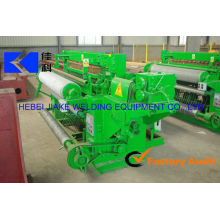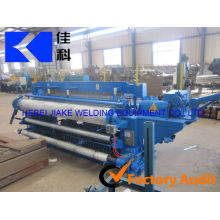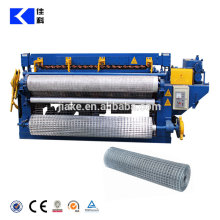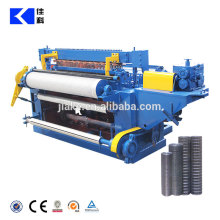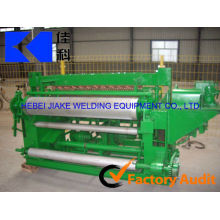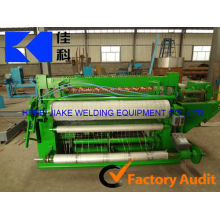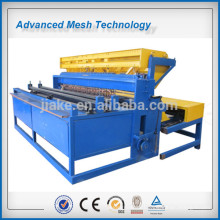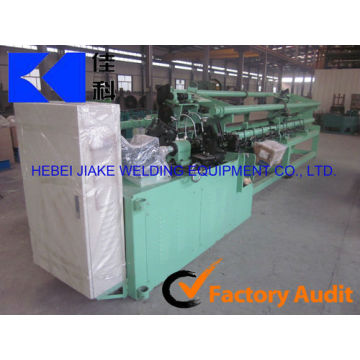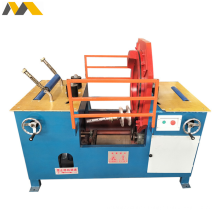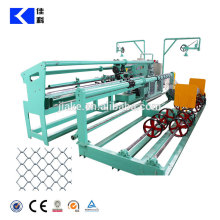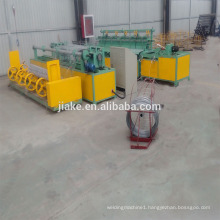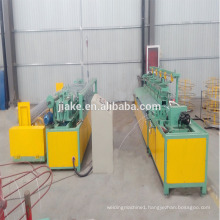automatic hurricane fence machine China supplier
Basic Info
Model No.: JK
Product Description
Specifications
chain-link fence (also referred to as wire netting, wire-mesh fence, chain-wire fence, cyclone fence, hurricane fencechain-link fence (also referred to as wire netting, wire-mesh fence, chain-wire fence, cyclone fence, hurricane fence, or diamond-mesh fence) is a type of woven fence usually made from galvanized or LLDPE-coated steel wire. The wires run vertically and are bent into a zig-zag pattern so that each "zig" hooks with the wire immediately on one side and each "zag" with the wire immediately on the other. This forms the characteristic diamond pattern seen in this type of fence.

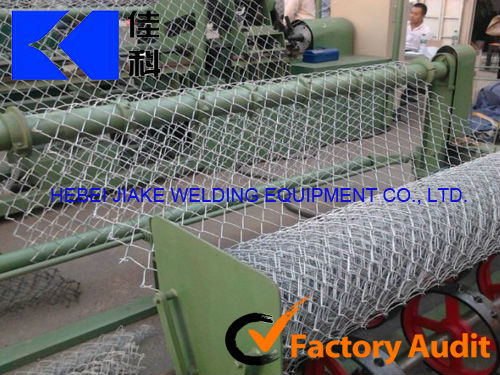

Sizes and uses
In the United States, fencing usually comes in 20 rod and 50 ft rolls which can be joined by "unscrewing" one of the end wires and then "screwing" it back in so that it hooks both pieces. Common heights include 3 ft, 3 ft 6 in, 4 ft, 5 ft, 6 ft, 7 ft, 8 ft, 10 ft, and 12 ft, though almost any height is possible. Common mesh gauges are 9, 11, and 11.5. Mesh length can also vary based on need, with the standard mesh length being 2". For tennis courts and ball parks the most popular height is 10 ft, and tennis courts use a mesh length of 1.75". The popularity of chain-link fence is due to its relatively low cost and ease of installation. A further advantage is that due to the open weave, chain-link fences are transparent, and do not obscure sunlight from either side of the fence. One can make a chain-link fence semi-opaque by inserting slats into the mesh.
Development of chain-link fencing
In the United Kingdom the firm of Barnard, Bishop & Barnard was established in Norwich to produce chain-link fencing by machine. The process was developed by Charles Barnard in 1844 based on cloth weaving machines (up until that time Norwich had a long history of cloth manufacture).
Anchor Fence (established in 1898) bought the rights to the machine, and was the first US company to manufacture chain-link fencing in the United States. Anchor Fence, also holds the first US patent of chain-link. The machine was purchased from a man in 1845 from Belgium who originally invented the wire bending machine.
Manufacturing
The manufacturing of chain-link fencing is called weaving. A metal wire, often galvanized to reduce corrosion, is pulled along a rotating long and flat blade, thus creating a somewhat flattened spiral. The spiral continues to rotate past the blade and winds its way through the previous spiral that is already part of the fence. When the spiral reaches the far end of the fence, the spiral is cut near the blade. Next, the spiral is pressed flat and the entire fence is moved up, ready for the next cycle. The end of every second spiral overlap the end of every first spiral. The machine clamps both ends and gives them a few twists. This makes the links permanent.
An improved version of the weaving machine winds two wires around the blade at once, thus creating a double helix. One of the spirals is woven through the last spiral that is already part of the fence. This improvement allows the process to advance twice as fast.
Notable uses
- Used to notable effect in the Gehry Residence by Frank Gehry
- Wrestling steel cage matches
- Backstops used in baseball and softball fields
- Before the advent of gravel trap in the later half of the 1980s, chain-link fencing was used as catch fences in racetracks to slow out-of-control cars down before they impact barriers. In the 2000s they continued to be used at American dirt tracks.
- Many parks in London were fitted with chain-link fencing during the Second World War when the original iron and steel railings were removed for the war effort (though many are now being replaced).[4]
A chain-link privacy fence topped with razor wire protecting a utility power substation.
Chain-link fencing at an American short track


We can customize the fence mesh welding machines, reinforcing mesh welding machine,
animal cage mesh welding machine, wire mesh welding machine, welded wire mesh machine,
chain link fence machine, hexagonal wire netting machine, gabion mesh machine, stone mesh
machine, expanded metal mesh machine, barbed wire machine, razor barbed wire machine and
so on, please do not hesitate to contact us.
Contact: Daisy Lee
Hebei Jiake Welding Equipment Co.,Ltd
Mobile: :+86-318-15324391556
Fax:+86-0318-7565522
Skype:qq1815361000
Email:qq1815361000 at live.com
Contact us if you need more details on Hurricane Fence Machine. We are ready to answer your questions on packaging, logistics, certification or any other aspects about Automatic Hurricane Fence Machine、Chain Link Fence Machine. If these products fail to match your need, please contact us and we would like to provide relevant information.
Product Categories : Chain Link Fence Machine > Semi-automatic Chain Link Fence Machine
Premium Related Products


